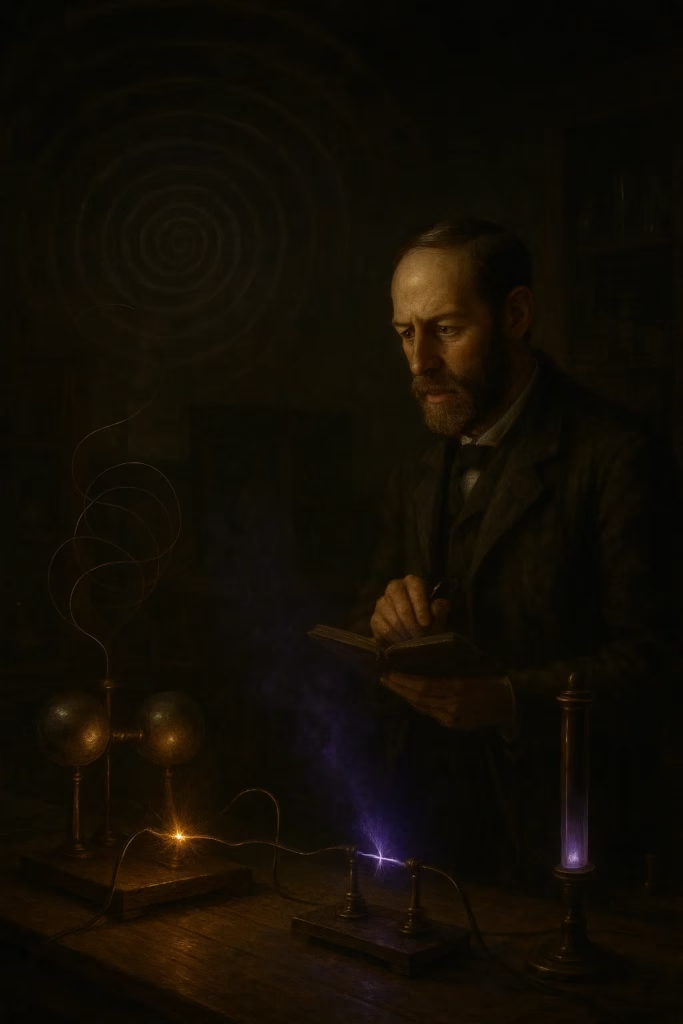Maxwell’s theory of electromagnetism was beautiful, complete, and mathematically perfect. It seemed everything was solved. All that remained was to experimentally prove the existence of the electromagnetic waves it predicted and confirm that their properties matched those of light. Then humanity could declare final victory and say: “We know what light is.”
📡 Hertz: The Man Who Confirmed Maxwell’s Theory and Discovered Something Entirely Different
The stage of our story moves from England to Germany. At the University of Karlsruhe, Heinrich Hertz conducted a series of brilliant experiments between 1886 and 1889. He managed to generate and receive a completely new type of electromagnetic wave – radio waves.
Hertz precisely measured their speed. It was the speed of light. He also measured their reflection, polarization, and interference. All measurements were in perfect agreement with Maxwell’s predictions. Hertz, humble to the core, interpreted his enormous contribution merely as “an experiment that proves Maestro Maxwell was right.” He saw no practical application for these “Hertzian waves,” though today we consider him a pioneer of radio technology, alongside Nikola Tesla.
It seemed the story of light was over.
However, during his experiments, Hertz noticed a strange, marginal phenomenon. He observed that the sparks in his receiving device (a spark gap) became stronger and longer when the apparatus was exposed to ultraviolet (UV) radiation. He had accidentally discovered the photoelectric effect.
Unfortunately, illness and premature death cut short the work of this brilliant scientist.
🔬 Lenard: Measuring the Unexplainable
Hertz’s work was continued by his collaborator, Philipp Lenard. He began to precisely measure the energy of electrons emitted from a metal cathode when light was shone upon it.
According to the prevailing wave theory, the energy of the emitted electrons should increase with the intensity (brightness) of the light. Stronger light = stronger wave = more energy for the electrons. Logical, right?
To great surprise, the experiment showed something entirely different:
- The energy of the electrons remained the same when the light intensity increased. Only the number of emitted electrons increased.
- The electron energy depended on the color (frequency) of the light! Blue light ejected electrons with higher energy than red light. And for red light, below a certain frequency, there was no electron emission at all, no matter how strong the source.
This was completely incomprehensible within the framework of classical physics. Lenard interpreted this in his own way, but his explanation could not account for why the energy depended on frequency.
💡 Einstein: The Quantum Leap of Thought
In Berlin, the young and unconventional Albert Einstein was closely following these results. He was not satisfied with the existing explanations. He found inspiration in the work of his older colleague, Max Planck.
A few years earlier, Planck had solved another major problem in physics – the problem of black-body radiation. Classical theory predicted a catastrophe: a hot body would radiate infinite energy in the ultraviolet part of the spectrum. For us to still exist, the Universe would have had to explode. Obviously, something was wrong.
Planck proposed a revolutionary yet very strange idea: energy is not emitted or absorbed continuously, but in certain, smallest possible packets – quanta. He expressed this mathematically with his famous equation:
E = h · f
Where E is the energy of a quantum, f is the frequency of radiation, and h is a new fundamental constant of nature – Planck’s constant.
Even Planck himself was unsure whether quanta were real or just a mathematical trick. He was a conventional man of the old school.
But Einstein was not. He boldly drew the logical conclusion: If energy is absorbed in quanta, then it is also transmitted in quanta. He applied Planck’s idea to the photoelectric effect and published his solution in 1905:
Light consists of particles – quanta of light (later called photons). The energy of each photon is given by Planck’s relation E = h·f.
This elegantly explained all of Lenard’s results:
- One photon interacts with one electron and transfers all its energy to it.
- The electron’s energy depends on the frequency (E = h·f), not on the intensity.
- The intensity of light determines the number of photons, and thus the number of ejected electrons.
- If the photon’s energy (h·f) is not sufficient to overcome the electron’s binding energy in the metal, the electron will not be ejected – no matter how many photons (high intensity) there are.
🏆 Victory for the Idea, but New Problems
This work of Einstein seemed like heresy to his contemporaries. Were they returning to Newton’s particles? Maxwell’s theory was so beautiful and complete! Even Max Planck, who had supported Einstein’s special theory of relativity, was skeptical this time.
But experiment had the final say. The predictions proved accurate. It was precisely for his explanation of the photoelectric effect that Albert Einstein received the 1921 Nobel Prize in Physics, not for his much more famous theory of relativity.
However, this opened Pandora’s box. We now had evidence for two natures of light:
- Wave-like (interference, diffraction – Young, Fresnel, Maxwell)
- Particle-like (photoelectric effect – Einstein)
How was this possible? How can something be both a wave and a particle? This was just the first in a series of paradoxes brought by quantum mechanics – a theory that still baffles and fascinates us today.
In the next post, we will talk about Einstein’s other great contribution to light – stimulated emission, which decades later would lead to one of the most important inventions of the 20th century: the laser.


Leave a Reply